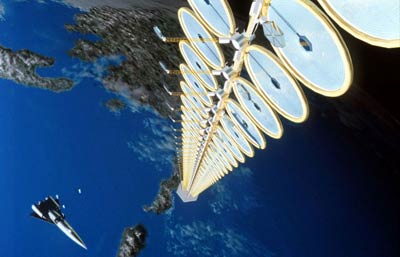Space solar power: why do we need it and what do we need to get it?by Taylor Dinerman
|
| The scientific and engineering principles of space solar power are well understood. The biggest obstacles are cost, of course, and the will to do it. |
Professor Nocera makes it clear that neither conservation nor wind, nuclear, hydro, or biomass energy sources are going to be able, even when taken together, to fill the demand for energy that any reasonable standard of living will require. China and India alone will need more energy than is produced today by the entire planet. Coal, oil, and gas could provide some of the answer but environmental and security reasons tend to rule out those alternatives. Even if one is skeptical of the whole anthropomorphic global warming theory, there are good reasons to want to minimize the use of oil and natural gas and to tread carefully when it comes to using coal as a primary energy source.
So his solution is to go for solar energy in a big way. Above all, he wants us to use it make hydrogen fuel, using artificial photosynthesis instead of the more familiar photovoltaic process. That requires a number of scientific breakthroughs that Nocera claims are within reach.
One certainly hopes so, but there is an alternative that is within our technological grasp: space solar power. The scientific and engineering principles are well understood. The biggest obstacles are cost, of course, and the will to do it. According to one estimate, large-scale solar electricity production could begin on the Moon within 20 years at a per kilowatt price of 10 to 15 percent premium over current rates. There are other estimates that tend to be more optimistic, but this one sounds about right.
Solar power from both the Moon and from satellites would provide energy for operations in space and could be beamed down to Earth using either lasers or microwaves. The great advantage of beamed power is that it does not have to be transmitted across the giant transcontinental grids as it done today. Multiple solar power satellites, along with a large set of arrays on the Moon, would be the basis of a system that would be far more robust and reliable than our current one, which suffers from occasional blackouts such as the one suffered along the US East Coast in August 2003, or the terrorist campaign that is being carried out today against the Iraqi electricity grid.
Distributed receiver antennas (rectennas) would receive power directly from space and would be easier to isolate from a large grid than is the case with today’s large power plants. It is also the case that it would be fairly easy to replace one beam with another in case a satellite or lunar array went down. Just as the current grid needs to have lots of reserve capacity to deal with peak demands, a space-based system would need its own reserves.
Another related factor that makes space based power attractive is that developing nations will not need to build and maintain expensive electrical distribution grids. Relatively small autonomous rectenna-fed power grids can operate independently. This may also have limited benefits for conservation efforts, since power lines will no longer have to be built through environmentally sensitive areas such as forests and parks.
Most important of all is that fact that these systems can be built in space with little or no direct input from Earth. Once the basic machinery needed to manufacture the lunar arrays and to launch the solar power satellites is up and running on the Moon, the costs to build and operate each new facility will go down incrementally. Unlike on Earth, each new satellite will not need an environmental impact statement or other complex and expensive legal processes. New ones can be put into service as fast as they can be built, and this alone may make the far more feasible a solution to the Earth’s energy problems than anything that can be done on the surface.
| Space solar power is going to be the “long pole” in the economic development of the solar system. |
As the needs for new energy sources overwhelm the world’s leaders, space solar power will become one of the most important parts of the future global energy mix. Most of the technologies needed for these systems are already being developed as part of NASA’s Vision for Space Exploration. The giant Ares 5, with its LEO capacity of 100-plus tons, will naturally be the principal way to get the first sets of equipment to the Moon’s surface.
What is not so obvious is the need for a fairly modest “space tug” to move the finished part of SPS complexes from lunar orbit to geosynchronous obit around the Earth. There are a number of designs, but one of the most promising was a version of Boeing’s solar-powered maneuvering unit for which some preliminary design studies were done in the early part of this decade. For these types of vehicles, ion engines are by far preferable to chemical engines. There is no rush to move the payloads around cislunar space and there are better things to do with the lunar-manufactured liquid hydrogen and oxygen than to burn them up shifting low-priority cargo from one orbit to another.
Space solar power is going to be the “long pole” in the economic development of the solar system. The infrastructure that will be used to build up this generating capacity will also be of use developing off-world mining, manufacturing, and even large-scale farming. Once relatively cheap electric power can be beamed from the Moon or from orbit to any place in the Earth-Moon system people will inevitably seek out ways to use it profitably. What was once called the “Third Industrial Revolution” will have truly begun.
